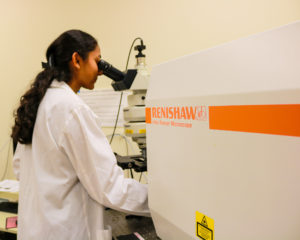Home⁄ Facilities⁄ Instruments⁄ User Instruments⁄ Spectroscopy and Electronic Measurements⁄ Renishaw InVia Confocal Raman microscope
Renishaw InVia Confocal Raman microscope
 Bard Hall SB30
Bard Hall SB30General Lab Safety (Online EH&S training available) Laser Safety (Online EH&S training available)
Specifications
Reflection Raman microscopy enables chemical identification of elements and compounds with a spatial resolution of ~1 µm. Raman shifts within 150 cm-¹ of the excitation frequency can be measured at excitation wavelengths of either 488 nm, 532 nm, or 785 nm, with a spectral resolution of ~1 cm-¹. The 532 nm laser can be used with the ultra-low frequency (ULF) filter to measure Raman shifts as low as 15 cm-1. When the 532 nm laser is used with a 600 l/mm grating and a conventional edge filter, high-speed large-area spatial maps of Raman spectra can be acquired in the Streamline mode.
2D and 3D spatial maps of Raman intensity over areas as large as several square cm can be made using an automated scan stage with any of the lasers–using 3D Volume Mapping of moderately absorbing samples, the Raman intensity can surveyed to depths of multiple microns into the sample. The Renishaw wdf file format has been developed to enable handling data files that contain up to 50 million spectra each. 2D maps can be made in either the StreamLine Plus or StreamLineHR mode. With StreamLineHR, Raman images can be acquired as point maps at a data rate of ~50 milliseconds per spectrum. This data rate is still 2 to 3 times slower than StreamLine Plus imaging software, which enables fast imaging by using a laser that is shaped into a line. However the line-mapping capability of StreamLine Plus cannot be used in 3D and has a spatial resolution limited by the CCD detector pixel size, so StreamLineHR does offer some advantages over StreamLine Plus.
Curved or irregular surfaces can now be surveyed for topography in advance of Raman imaging so the focus is adjusted to keep the sample in focus during data acquisition. This automated focusing makes imaging large areas more user-friendly because the focus does not have to be adjusted manually.
Other specialized applications: a) polarized Raman; b) photoluminescence; c) simultaneous Raman/AFM.
Equipment
Renishaw InVia microRaman system. Objectives:
- 5x,
- 10x,
- 20x,
- 50x (N.A. 0.75 for Raman imaging),
- 50x (N.A. 0.45 for Raman imaging, long-working distance),
- 100x (N.A. 0.9 for Raman imaging)
- Standard Operating Procedure
- Instructions for addressing low counts when motorized elements block the beam path
- Use this procedure to make a montage of white-light images for locating your Raman map
- Operating Procedure for using 532 nm laser and ULF filter down to 80 cm-1
- How to Correct Calibration Offset if Quick Calibration Fails
- Standard Operating Procedure for 532 nm laser
- Renishaw training modules
- There are a number of training modules offered by Renishaw for users with a Cornell email account. Users can access them by creating a MyRenishaw account. External users without a Cornell email address should contact the facility manager for further details.
For rates information, please see the rates page.

Kevin Silverstein
(607) 254-3307
kws74@cornell.edu
Thurston Hall, Room 113
Secondary Contact

Mark Pfeifer
(607) 255-4161
map322@cornell.edu
Bard Hall, Room B-57
